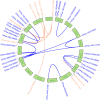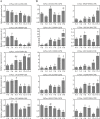Insight into the CBL and CIPK gene families in pecan (Carya illinoinensis): identification, evolution and expression patterns in drought response
- PMID: 35484502
- PMCID: PMC9047272
- DOI: 10.1186/s12870-022-03601-0
Insight into the CBL and CIPK gene families in pecan (Carya illinoinensis): identification, evolution and expression patterns in drought response
Abstract
Background: Calcium (Ca2+) serves as a ubiquitous second messenger and plays a pivotal role in signal transduction. Calcineurin B-like proteins (CBLs) are plant-specific Ca2+ sensors that interact with CBL-interacting protein kinases (CIPKs) to transmit Ca2+ signals. CBL-CIPK complexes have been reported to play pivotal roles in plant development and response to drought stress; however, limited information is available about the CBL and CIPK genes in pecan, an important nut crop.
Results: In the present study, a total of 9 CBL and 30 CIPK genes were identified from the pecan genome and divided into four and five clades based on phylogeny, respectively. Gene structure and distribution of conserved sequence motif analysis suggested that family members in the same clade commonly exhibited similar exon-intron structures and motif compositions. The segmental duplication events contributed largely to the expansion of pecan CBL and CIPK gene families, and Ka/Ks values revealed that all of them experienced strong negative selection. Phylogenetic analysis of CIPK proteins from 14 plant species revealed that CIPKs in the intron-poor clade originated in seed plants. Tissue-specific expression profiles of CiCBLs and CiCIPKs were analysed, presenting functional diversity. Expression profiles derived from RNA-Seq revealed distinct expression patterns of CiCBLs and CiCIPKs under drought treatment in pecan. Moreover, coexpression network analysis helped to elucidate the relationships between these genes and identify potential candidates for the regulation of drought response, which were verified by qRT-PCR analysis.
Conclusions: The characterization and analysis of CBL and CIPK genes in pecan genome could provide a basis for further functional analysis of CiCBLs and CiCIPKs in the drought stress response of pecan.
Keywords: CBL-CIPK; Carya illinoinensis; Drought; Evolution; Gene expression.
© 2022. The Author(s).
Conflict of interest statement
The authors declare no conflict of interest.
Figures








Similar articles
-
Evolution of the CBL and CIPK gene families in Medicago: genome-wide characterization, pervasive duplication, and expression pattern under salt and drought stress.BMC Plant Biol. 2022 Nov 3;22(1):512. doi: 10.1186/s12870-022-03884-3. BMC Plant Biol. 2022. PMID: 36324083 Free PMC article.
-
Evolution of an intron-poor cluster of the CIPK gene family and expression in response to drought stress in soybean.Sci Rep. 2016 Jun 17;6:28225. doi: 10.1038/srep28225. Sci Rep. 2016. PMID: 27311690 Free PMC article.
-
Identification of the CIPK-CBL family gene and functional characterization of CqCIPK14 gene under drought stress in quinoa.BMC Genomics. 2022 Jun 16;23(1):447. doi: 10.1186/s12864-022-08683-6. BMC Genomics. 2022. PMID: 35710332 Free PMC article.
-
The CBL-CIPK Pathway in Plant Response to Stress Signals.Int J Mol Sci. 2020 Aug 7;21(16):5668. doi: 10.3390/ijms21165668. Int J Mol Sci. 2020. PMID: 32784662 Free PMC article. Review.
-
Molecular Mechanisms of CBL-CIPK Signaling Pathway in Plant Abiotic Stress Tolerance and Hormone Crosstalk.Int J Mol Sci. 2024 May 6;25(9):5043. doi: 10.3390/ijms25095043. Int J Mol Sci. 2024. PMID: 38732261 Free PMC article. Review.
Cited by
-
Comparison of Transcriptome between Tolerant and Susceptible Rice Cultivar Reveals Positive and Negative Regulators of Response to Rhizoctonia solani in Rice.Int J Mol Sci. 2023 Sep 20;24(18):14310. doi: 10.3390/ijms241814310. Int J Mol Sci. 2023. PMID: 37762614 Free PMC article.
-
Diverse roles of the CIPK gene family in transcription regulation and various biotic and abiotic stresses: A literature review and bibliometric study.Front Genet. 2022 Nov 15;13:1041078. doi: 10.3389/fgene.2022.1041078. eCollection 2022. Front Genet. 2022. PMID: 36457742 Free PMC article. Review.
-
Ammonium-nitrate mixtures dominated by NH4+-N promote the growth of pecan (Carya illinoinensis) through enhanced N uptake and assimilation.Front Plant Sci. 2023 May 29;14:1186818. doi: 10.3389/fpls.2023.1186818. eCollection 2023. Front Plant Sci. 2023. PMID: 37313261 Free PMC article.
-
The Integrated Analysis of miRNome and Degradome Sequencing Reveals the Regulatory Mechanisms of Seed Development and Oil Biosynthesis in Pecan (Carya illinoinensis).Foods. 2024 Sep 16;13(18):2934. doi: 10.3390/foods13182934. Foods. 2024. PMID: 39335863 Free PMC article.
-
Genome-Wide Identification and Expression Analysis of AMT and NRT Gene Family in Pecan (Carya illinoinensis) Seedlings Revealed a Preference for NH4+-N.Int J Mol Sci. 2022 Nov 1;23(21):13314. doi: 10.3390/ijms232113314. Int J Mol Sci. 2022. PMID: 36362101 Free PMC article.
References
MeSH terms
Substances
LinkOut - more resources
Full Text Sources
Molecular Biology Databases
Miscellaneous

